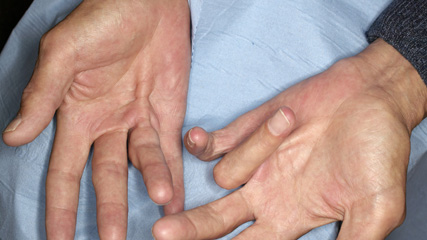We know that diabetes can affect your eyes as well as your heart but did you know that it can affect your bones too? We’ve listed down the three most common bone problems related with diabetes. Just drink your medicine for diabetes and you just might avoid ‘em!
Frozen shoulder

The term "Frozen" has absolutely nothing to do with ice but rather a physical problem. It is described as pain in the shoulder that limits one's movement and motion. More often than not, it only affects one shoulder, not both.
Causes and Risk Factors
Frozen shoulder occurs when the capsule around your shoulder joint becomes swollen. There is no explanation as to why this happens if you are a diabetic, then it is bad news for you as according to studies, this affects 10-20 percent of all diabetics. Another risk factor is your gender as women are more prone as compared to men.
Symptoms
If you are having a difficult time to perform simple daily tasks such as bathing, driving or dressing and you are feeling pain and stiffness in your shoulder, you may have a Frozen Shoulder. This is accompanied by difficulty to move your shoulder. There are three stages:
- Freezing- Usually lasts from six weeks to nine months. During this stage, the pain slowly worsens until you cannot move the joint at all.
- Frozen- Usually lasts from four to six months. During this stage, the pain has eased up but there is still a loss in motion.
- Thawing- Usually lasts from six months to two years. Slowly but surely, the pains has gone away as well as a vast improvement in movement wherein you can move the shoulder the way you used to or near it.
Treatment
If detected early, your doctor may recommend pain killers such as non-steroidal anti-inflammatory drugs (NSAID). He or she may also prescribe corticosteroid if the pain is unbearable. Therapy may also be recommended.
Diabetic hand syndrome

Also called cheiroarthropathy or Stiff Hand Syndrome, Diabetic Hand Syndrome is a disorder wherein one cannot straighten the fingers. It may affect just one hand or even both.
Causes
There is no known reason to why people develop Diabetic Hand Syndrome but it is more prominent among those who have been diabetic for several years.
Symptoms
You may notice that you feel stiffness in your fingers which will spread to your thumb and onto the rest of your digits. You will also see that you cannot straighten out your fingers. You may also notice waxy, thick and tight skin at the back of your hand.
One of the ways to diagnose this disorder is by having the patient hold their hands in a prayer position with the palms touching each other, same with the fingers. If the patient is unable to have the joints of their hands touch each other, the doctor may diagnose you with Diabetic Hand Syndrome.
How is it treated?
Your doctor may recommend physical therapy as well as exercise. They will also recommend you to manage your blood sugar better. Do not force your hands to stretch as this may only damage your hands.
Dupuytren's Contracture

It may sound like a phrase straight out of an English lesson but Dupuytren’s Contracture is anything but that. What Dupuytren’s Contracture is a disorder wherein one or more of your digits are curled up towards your palm.
Causes and Risk Factors
There is no known cause for Dupuytren's Contracture but there are several risks.
Among the reasons why you may develop this disorder is genetics as well as ancestry. Genetics refer to the disease being inherited while ancestry refers to your lineage such as you may be of European descent or Asian. Another would be gender wherein men are more prone to develop Dupuytren's Contracture as well as age as it tends to appear after 40. Anyone with diabetes or seizure disorders are also likely to have this disease.
Symptoms
The symptoms do not come all at once. It progresses over the course of weeks or months, depending on the patient.
You may notice weird lumps or dimples appearing on your skin as well as the the thickening of the skin on your palm. You may also feel your grip weakening as well as the finger being drawn towards your palm. Among all your digits, it is the ring and pinky fingers that are usually affected.
Treatment
One option for treatment is surgery wherein the tissue is removed to give the patient better mobility. Another would be physical therapy. Steroid injections are recommended for mild cases wherein lumps of tissue are flattened using the injections.
Keep up a healthy lifestyle and check your blood sugar on a regular basis and for sure you won’t have problem at all.